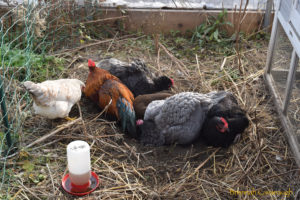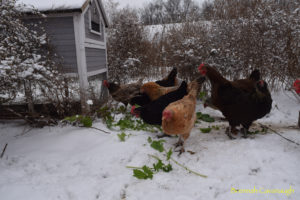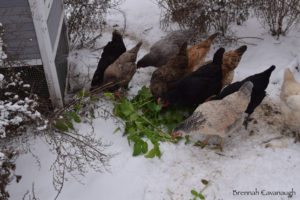As I went out to close up the chicken coops this evening after they should have all been on their roosts, I was briefly startled to see one of the hens still out, and looking at me like she needed help. Then I remembered; the inner door to that coop had been closed earlier, and I’d forgotten to open it so they could get inside. Sure enough, there were the other two chickens that slept in that coop, at the top of the ladder in front of the closed door. One of them, the bantam (miniature) rooster, hopped down and came over to me as I came into their enclosure, so when I opened the door, only Little Wing saw it open and went in. The other two were still just looking at me, seemingly looking for help. I was just considering picking them up and putting them into the coop when I heard Little Wing calling them from inside.
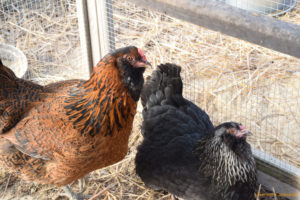
Chickens have a specific sound they make to call each other, but it is usually used to call others to some sort of tasty morsel or food. It is used mostly by roosters to call the hens to a treat he’s found, or by mother hens teaching their chicks how to find food. Sometimes roosters also use it when they think they’ve found a good spot to lay an egg and want to let the hens know (and there’s another more specific sound they use for that as well).

After Little Wing called them, the other two found their way in fairly quickly.


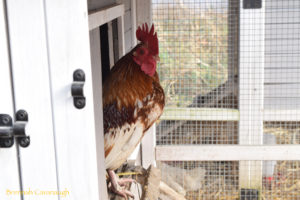 When we first moved the ‘front yard flock’ of chickens into the hoophouse, only one hen was laying eggs, and some of the chickens were missing feathers. Both were things that are fairly normal for the time of year it was; chickens molt, and replace all their feathers so that they can have fresh feathers for winter to keep them warm. This takes a lot of energy for them and also causes them to slow or stop laying altogether for a little while.
When we first moved the ‘front yard flock’ of chickens into the hoophouse, only one hen was laying eggs, and some of the chickens were missing feathers. Both were things that are fairly normal for the time of year it was; chickens molt, and replace all their feathers so that they can have fresh feathers for winter to keep them warm. This takes a lot of energy for them and also causes them to slow or stop laying altogether for a little while.

